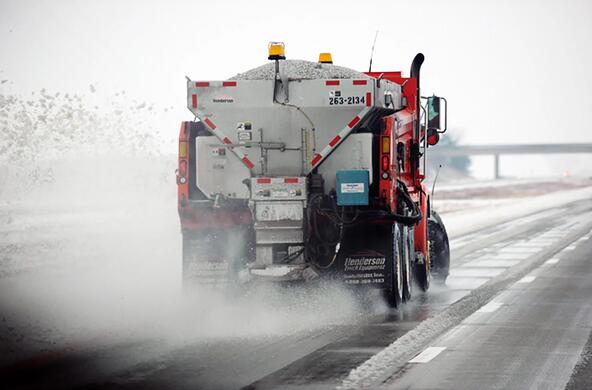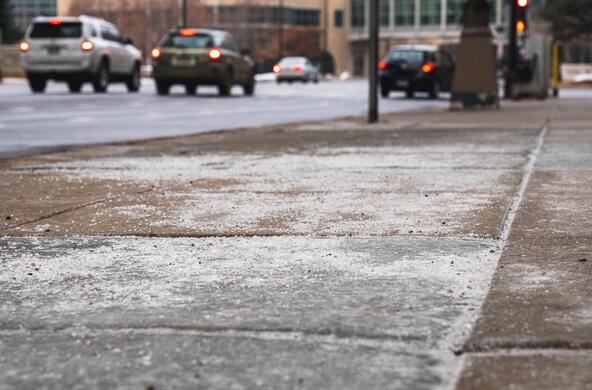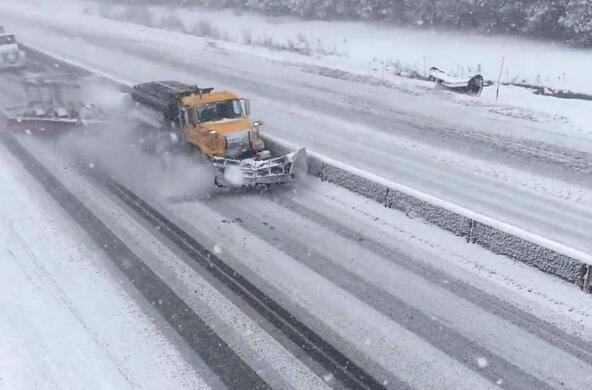Prices Surge After Heavy Snowfalls Last Winter All But Wiped Out Stocks
Officials across the country are scrambling to get enough road salt this year, after last winter’s brutal weather largely cleaned out stockpiles.
“This year’s looking much better so far,” said Todd Matheson, a state maintenance engineer with the Wisconsin Department of Transportation, though prices nationwide have risen about 20% from last winter.
Wisconsin uses just over 500,000 tons of road salt a year, on average. But recent winters have been severe and the state has more than 560,000 tons contracted for this year with some 141,000 tons extra in reserve for the roughly 12,000 miles of road the Transportation Department must keep clear.
“Overall last winter’s weather was early, exceptionally heavy and prolonged,” said Tara Hart, spokeswoman for Compass Minerals International Inc., based in Overland Park, Kan., and one of the largest suppliers of road salt in North America. “What it means is that we and our customers started with essentially zero inventory this season.”
Compass’s mines and plants have been working nonstop, which is unusual this time of year, Ms. Hart said, churning out the roughly 10.5 million tons of salt the company can produce annually. The price increase this year hasn’t cut back on contracts because road de-icing isn’t something municipalities can afford to cut back on. “The demand does not go away. Because everyone needs salt,” she said.
The National Weather Service says a repeat of last year’s extreme cold and heavy snows doesn’t look likely this year. Jack Boston, a senior meteorologist with AccuWeather.com, said this week likely won’t bring any major snowstorms, but he said winter storms will kick in around mid-January and bring a winter with above-average snowfall.
The short supplies of salt are affecting large municipalities and even smaller vendors selling bags of salt for driveways like De Pere True Value Hardware in this small city neighboring Green Bay, which typically gets more than 50 inches of snow each winter, according to the National Weather Service.
New York City averages 25.1 inches of snowfall a year, according to AccuWeather.com. Last year, the city saw more than double its average, tallying 57 inches.
“We actually still have some on back-order,” said Allen Hoopingarner, the store’s manager. “Normally that doesn’t happen until January.” Prices have gone up on some of the brands they carry, but that doesn’t deter homeowners who have to salt their drives. “For the most part people need it and will buy it,” he said.
In Massachusetts, the state’s Transportation Department has plenty of salt on hand—recently about 314,500 tons—but had to pay a hefty sum to get it after last year’s rough winter, said spokesman Mike Verseckes. The state locked in prices between $70 and $71 a ton in September, a 36% increase from the last fiscal year, and around the highest price the state has paid in five years, state data show. “It’s just market forces driving an increase,” Mr. Verseckes said.
Last January, the first storm of the season hit Atlanta and wreaked havoc, stranding thousands of people in gigantic traffic jams caused by icy roads and accidents in a region unaccustomed to such weather. Many people, including schoolchildren, spent the night in vehicles, while others slept in stores, schools, fire stations and churches. This season, Georgia’s Department of Transportation has about 28,000 tons of salt on hand and is receiving 12,000 tons more, spokeswoman Annalysce Baker said.
The department has found it harder to get salt because of the national shortage, and the quality of the salt has gone down, but the state has what it needs for this season, she said.
The U.S. Geological Survey has said profligate use of salt contributes to greatly increased chloride levels in streams and ground water, which can harm aquatic life. A study released in mid-December found 84% of urban streams had greatly elevated chloride levels and 29% of sites monitored posed serious risks to local organisms during some of the year, according to U.S. Environmental Protection Agency standards. In some water supplies, "you’re seeing levels come up above what is considered to be toxic," said Steve Corsi, a research hydrologist with the USGS in Wisconsin.
Environmental groups are encouraging alternatives to salt, like using a saltwater solution sprayed before snow even begins falling that sticks to the road better and prevents the scattering that can come with rock salt. The more targeted approach can save on the amount of salt purchased, but raises upfront costs for new equipment.
“We’re really working on getting the word out that there are things to do to improve the efficiency of your salt,” said Victoria Kelly, manager of environmental monitoring at the Cary Institute of Ecosystem Studies, a nonprofit based in Millbrook, N.Y.
Some states have added road treatments like potassium-chloride and calcium-chloride sprays that work at even lower temperatures than standard salt and can reduce costs over the duration of an entire winter. States like New York use saltwater pumped up as a byproduct of oil and natural-gas drilling—determined to be nontoxic—to spray on some roads. Some municipalities have also been mixing more sand and grit into their salt to cut costs.
Back in De Pere, some savvy shoppers have figured out a way to get around rising prices for the road salt they buy at the hardware store. “Some people will buy water-softener salt because it’s cheaper,” said Mr. Hoopingarner, the store manager. “It works.”








